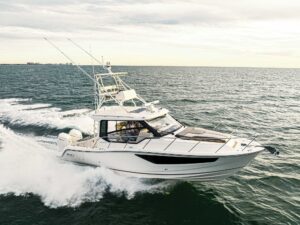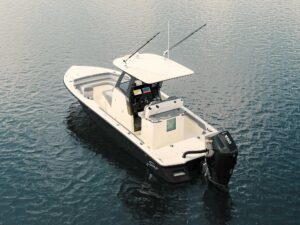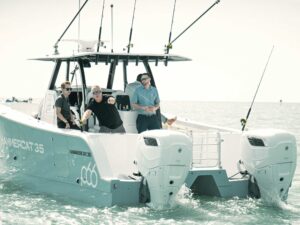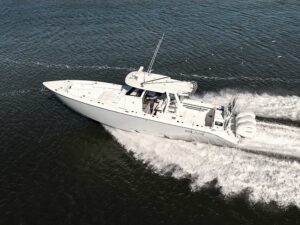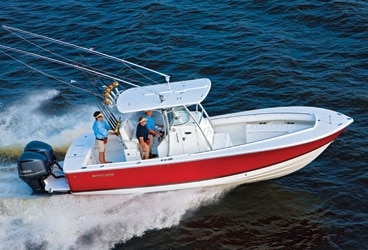
1210_Regulator_368
In 1990 an upstart boatbuilder from North Carolina introduced a 26-foot center console that redefined what fishermen expect in a midsize open fishing boat. Today, 1,488 Regulator 26s later, the company is revising that classic fish boat with the introduction of the 28 FS.
“The 28 FS is the culmination of years of customer and dealer suggestions on how to make the 26 even better,” says Owen Maxwell, who, with his wife, Joan, has owned and operated the company since its inception. “The only problem we faced was we couldn’t fit it all into a 26-foot platform.”
My first peek was at the dock at Pirate’s Cove in Manteo, North Carolina, where the red-and-white beauty sat in the fading afternoon sun on a late October day. It shares the lines of the original 26, but in a more graceful and refined manner. There is hardly a straight line on the boat that isn’t softened by rounded corners. For example, the transom bows ever so slightly outward and meets the hull sides with radii that match the curve of the Armstrong bracket supporting the Yamaha F300 outboards.
The more I looked at design treatments both large and small, the more it became apparent that hundreds of hours of thought and planning went into this boat. Case in point, the new console features angled mounting surfaces that provide the optimal viewing perspective for a pair of LCD screens as large as 15 inches. Below it the mounting surface steepens for ease of viewing the Command Link Plus gauge and switch panel. A handy padded tray for cell phones is located between the cup holders, and a molded door opens to reveal a dry compartment for glasses, logbooks and other stuff. Looking down, there is a large step box with recessed toe space beneath it. Inside the console, the head compartment has 6½ feet of headroom, and a 74-quart drink cooler on the forward face forms the base for twin seats complete with padded backrests and headrests.
The transom offers a full-width illuminated fish box, a fiberglass walk-through door and a recessed drop-down seat that is protected by a flush-fitting fiberglass bottom when not in use. A deck hatch provides access to the gelcoated bilge area, through-hull fittings and pumps. The test boat featured the optional 2X deluxe tackle center and high-back helm seats with fold-up bolsters that serve as a leaning surface when standing. Another leaning-post option includes a 40-gallon livewell.
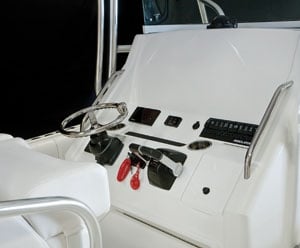
The FS stands for forward seating, which with cushions in place provides comfortable lounging and without becomes a large casting platform. The three bow compartments are insulated, the two side units drain overboard, and all feature gasket hatches. The bow rail is low and recessed inboard of the wide gunwale, and the anchor locker will hold more rode than you’ll ever need. A deck hatch opens to reveal a 456-quart insulated fish box that doubles as locking rod and gaff storage. Fit and finish throughout are superb, and all parts fit snugly and securely, as they should.
I spent the following day with Owen Maxwell and his pal Brendan Strum on a real-world test, running the boat offshore to fish for tuna. The prior 24 hours had seen strong winds shift around three-quarters of the compass, and when we exited Oregon Inlet, the prevailing swell from the south was running a tight two to four feet or better, with a confusing chop. The 28 seemed unfazed as we ran bow into the mess for 48 miles, maintaining a relatively constant 25-knot cruise. The 28’s pronounced flare kept the spray out of the boat and off the nicely executed three-sided enclosure. We spent the next six hours trolling, catching blackfin tuna, a rarity off the Outer Banks. The boat handled seven lines easily from the double-rigged 16-foot Lee’s Tackle outriggers deployed from Sidewinder bases in the fiberglass T-top. The top is every bit as refined as the rest of the boat, with rounded corners, rolled edges, a molded-in radio box and spreader lights. There are raised and reinforced mounting surfaces for antennas on top and a radar dome with a built-in conduit for running the cables cleanly back to the console.
I ran the boat back to the inlet, taking the seas quartering and abeam and varying the cruise from 35 to 45 mph. The hull performs particularly well at faster speeds, and the boat has plenty of speed to offer, with a top end of just over 60 mph. At 4,100 rpm, the 300 Yamahas were making 41 mph, delivering 1.5 mpg, quite respectable for a fully loaded boat that tipped the scales around 11,000 pounds. The deep-V hull worked in concert with the bracketed outboards to provide a soft, dry ride that was just what the doctor ordered for my tender back. The Regulator 28 FS is not only the heir apparent to the still-popular 26, but for this scribe, it’s the new reigning champion in this size range.
Regulator 28 FS
LOA: 27’7″
Beam: 9’5″
Draft: 24″
Deadrise: 24 degrees
Weight: 8,260 lbs. dry (hull only)
Fuel: 235 gals.
Water: 33 gals.
Max hp: 600
Price: $159,995 (base price with test power)
Regulator Marine: 252-482-3837 • www.regulatormarine.com

